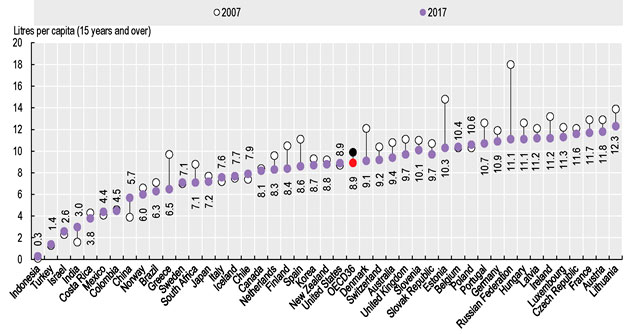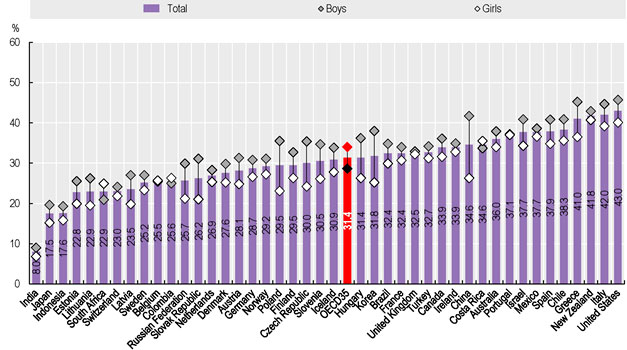|

|
HEALTH AT A GLANCE 2019
OECD Indicators
Paris, OECD Publishing, 2019, 243 pages
|
https://www.oecd-ilibrary.org/docserver/4dd50c09-en.pdf?
expires=1573225971&id=id&accname=guest&checksum=13BACD9C991D89AA360320A33FE14BC6
|
Зарегистрированное потребление алкоголя среди
взрослых, 2007 г. и 2017 г. (или ближайший год) (стр. 91)

Избыточный вес, включая ожирение среди детей 5-9
лет по полу, 2016 г. (стр. 99)

|
В очередном издании 2019 года "Health at a Glance"
представлены сопоставимые показатели здоровья населения и эффективности
системы здравоохранения в странах-членах ОЭСР, странах-кандидатах
и странах-партнерах. В публикации приводятся последние сопоставимые
данные по 80 показателям, отражающим различия между странами в состоянии
здоровья, факторах риска и поведении, связанном со здоровьем, доступе
и качестве медицинской помощи, а также финансовых и физических ресурсах,
доступных для здравоохранения. Наряду с анализом показателей-индикаторов,
в обзорной главе обобщены сравнительные показатели и основные тенденции
по странам, в том числе то, сколько расходов на здравоохранение
связано с уровнем укомплектованности персоналом, доступом, качеством
и результатами в отношении здоровья.
Table of contents
Executive summary
Reader's guide
Chapter 1. Indicator overview: comparative performance
of countries and major trends
Introduction
Health status
Risk factors for health
Access to care
Quality of care
Health care resources
To what extent does health spending translate into better access,
quality and health outcomes, and more health professionals?
Chapter 2. Measuring what matters for people-centred
health systems
Introduction
A people-centred health system needs to measure what matters to
patients
Joint replacement rates are rising but are patients reporting
improvement?
Better information on breast cancer care outcomes helps patients
facing difficult treatment choices
Existing mental health measures say little about experiences and
outcomes of care
Conclusion
Chapter 3. Health status
Trends in life expectancy
Life expectancy by sex and education level
Main causes of mortality
Avoidable mortality (preventable and treatable)
Mortality from circulatory diseases
Cancer incidence and mortality
Chronic disease morbidity
Infant health
Mental health
Self-rated health
Chapter 4. Risk factors for health
Smoking among adults
Alcohol consumption among adults
Opioids use
Diet and physical activity among adults
Overweight and obesity among adults
Overweight and obesity among children
Air pollution and extreme temperatures
Chapter 5. Access to care
Population coverage for health care
Extent of health care coverage
Use of primary care services
Unmet need for health care
Financial hardship and out-of-pocket expenditure
Geographic distribution of doctors
Waiting times for elective surgery
Chapter 6. Quality and outcomes of care
Safe primary care - prescribing
Safe acute care - surgical complications and health care-associated
infections
Safe acute care - obstetric trauma
Avoidable hospital admissions
Diabetes care
Mortality following ischaemic stroke
Mortality following acute myocardial infarction (AMI)
Hip and knee surgery
Care for people with mental health disorders
Breast cancer outcomes
Screening and survival for colorectal cancer
Survival for other major cancers
Vaccinations
Patient experiences of ambulatory care
Chapter 7. Health expenditure
Health expenditure per capita
Health expenditure in relation to GDP
Prices in the health sector
Health expenditure by financing scheme
Public funding of health spending
Health expenditure by type of service
Health expenditure by provider
Capital expenditure in the health sector
Projections of health expenditure
Chapter 8. Health workforce
Health and social care workforce
Doctors (overall number)
Doctors (by age, sex and category)
Remuneration of doctors (general practitioners and specialists)
Nurses
Remuneration of nurses
Medical graduates
Nursing graduates
International migration of doctors and nurses
Chapter 9. Health care activities
Consultations with doctors
Medical technologies
Hospital beds and discharge rates
Average length of stay in hospitals
Hip and knee replacement
Caesarean sections
Ambulatory surgery
Chapter 10. Pharmaceutical sector
Pharmaceutical expenditure
Pharmacists and pharmacies
Pharmaceutical consumption
Generics and biosimilars
Research and development in the pharmaceutical sector
Chapter 11. Ageing and long-term care
Demographic trends
Life expectancy and healthy life expectancy at age 65
Self-rated health and disability at age 65 and over
Dementia
Safe prescribing in older populations
Safe long-term care
Recipients of long-term care
Informal carers
Long-term care workers
Long-term beds in facilities and hospitals
Long-term care spending and unit costs
|

